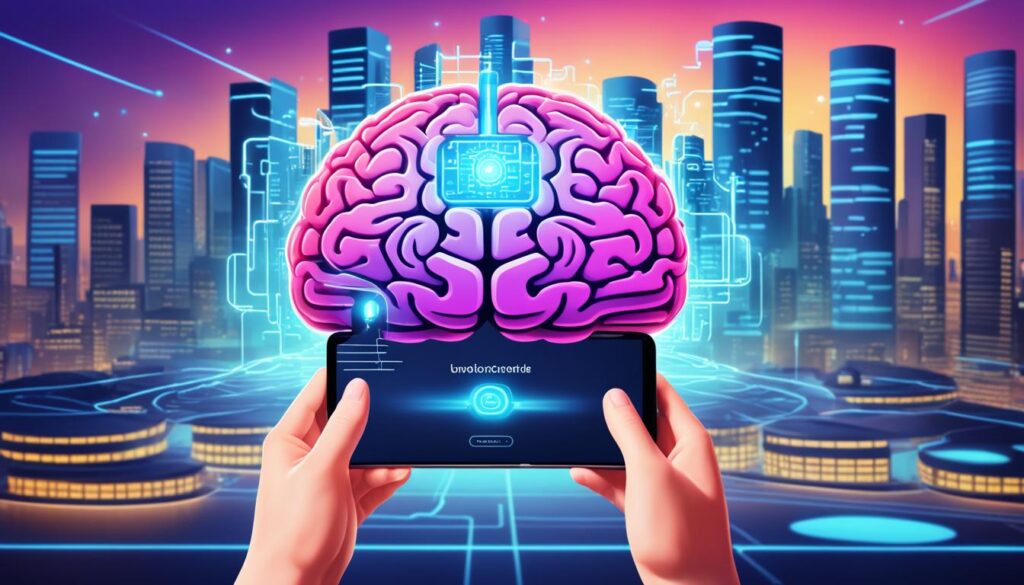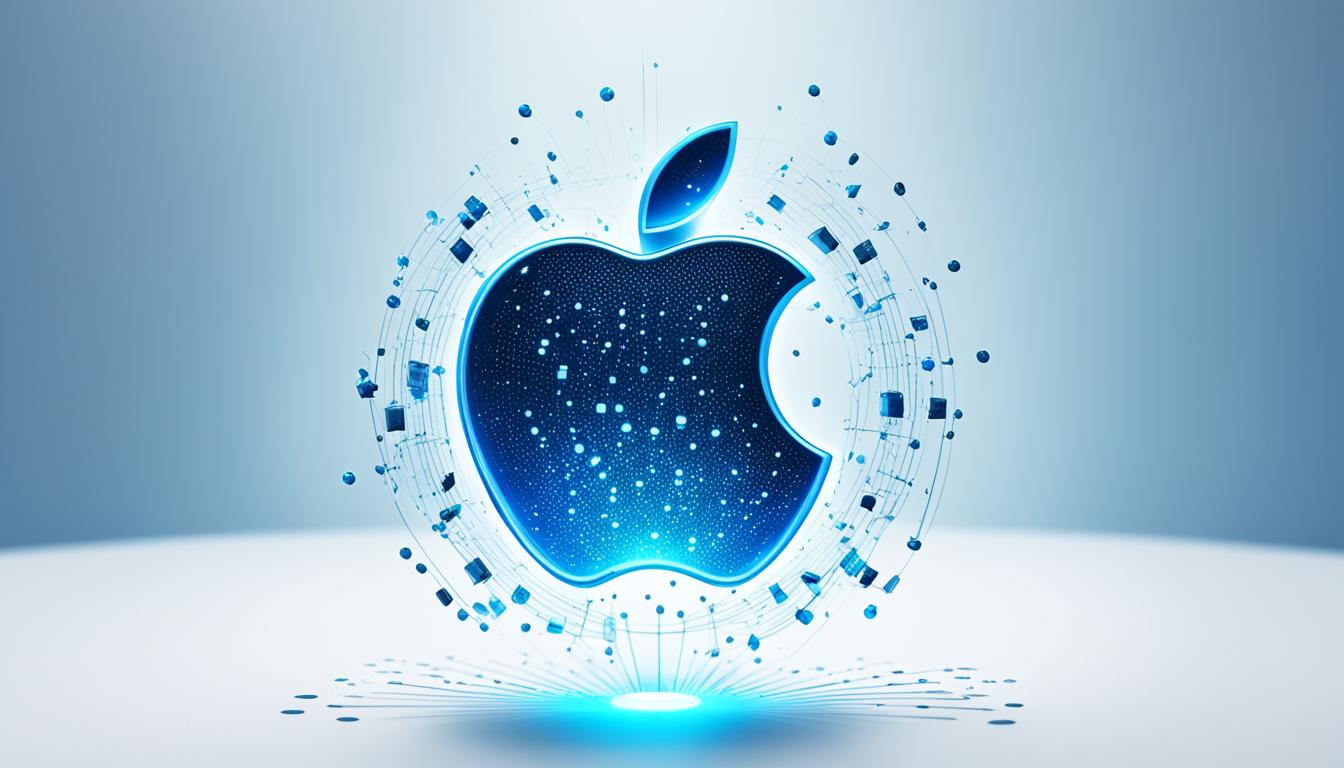Did you know about Apple’s innovative OpenELM? It’s changing the game for on-device AI.
As AI-powered apps become more popular, Apple released OpenELM. This tool lets AI work right on your devices, not in the cloud. This means better privacy and faster responses from AI features.
OpenELM is a toolkit for creating and testing AI, with a public data set. It invites developers and researchers to help make it better1. OpenELM’s smart design uses resources well, making devices smarter without slowing them down1. And with its future integration in iOS 18, Siri and other AI tools will get even better1.
Key Takeaways:
- Apple’s OpenELM boosts AI on devices, which means more privacy and quicker AI.
- It gives a full set of tools for AI creation and testing, encouraging contributions from developers and researchers.
- Expect more advanced AI features on Apple devices with OpenELM in iOS 18.
The Importance of On-Device AI
On-device AI is key in advancing AI tech. It provides real-time analysis, works efficiently, and doesn’t always need an internet connection2. Its importance grows as AI evolves, especially for privacy and efficiency.
One major plus of on-device AI is it works on personal devices like phones and laptops. This reduces delay and boosts privacy3. It processes data right on the device. This means it doesn’t send out sensitive info to far-off servers. This way, it lowers the risks of your data being stolen and boosts user privacy.
Also, on-device AI processes data fast and gives quick responses. This makes using it feel smooth4. By running AI tasks on the device instead of online, it uses less power. This means devices can last longer on a single charge. It boosts AI app performance and uses less energy. This helps protect our planet.
Furthermore, on-device AI models are often smaller and need less computing effort. This makes them run faster and perform better3. They’re made for specific tasks and can work on devices with less power. They use special hardware, like the Neural Engine in iPhones. This mix of technology allows for efficient energy use and makes devices work independently. On-device AI is essential for many AI features4.
Efficiency and privacy are at the core of AI tech. On-device AI tackles both issues well. With on-device AI getting better, we can enjoy AI features safely and without delay. By using the power of our own devices, on-device AI is changing the future of AI in many fields4.
The Features of Apple On-Device OpenELM
Apple’s On-Device OpenELM has many features that make it great for AI work. It lets developers and researchers do new things and change the way AI is used on devices. Let’s look at what makes Apple OpenELM special.
1. Open-Source and Collaborative Development
Apple made OpenELM open source to help it grow with help from developers everywhere. This teamwork helps the AI community share knowledge and create better AI for devices5.
2. Comprehensive Training Framework
With OpenELM, developers can train models well. They can use tools like training logs and checkpoints. This helps make models work better for different needs5.
3. Enhanced Privacy and On-Device Processing
OpenELM focuses on keeping AI tasks on the device to protect user privacy. This way, user data stays safe, following Apple’s promise to keep data secure5.
4. Efficient Parameter Allocation for Improved Accuracy
OpenELM improves accuracy by managing parameters smartly. This makes AI tasks on devices faster and more accurate, improving how AI apps work5.
5. Integration with iOS 18
Apple will add OpenELM to iOS 18, making on-device AI more accessible. This lets developers make AI features that work better and fit smoothly with iOS5.
In summary, Apple’s OpenELM gives developers the tools to make powerful AI on devices. It’s open-source, offers training tools, protects privacy, and works efficiently with iOS. These features help set a new benchmark for AI on devices5.

The Implications of On-Device AI
On-device AI dramatically changes the game for AI applications. It processes data on local devices, not in the cloud. This enables more collaboration and faster progress within the AI community.
Apple’s use of on-device AI puts them ahead in AI tech. It encourages sharing ideas and working together among developers and researchers3. This cooperation improves AI quality, leading to important discoveries.
On-device AI gives teams more freedom and power to innovate. They depend less on cloud processing. This leads to new opportunities and creative solutions.
On-device AI’s benefits also reach various sectors beyond tech. It processes data locally, enhancing privacy and security3. This is vital in areas like healthcare, finance, and cybersecurity, where keeping data private matters most.
On-device AI brings new features to everyday apps. It works offline, offering continuous operation and better user experiences3. From custom suggestions to understanding human language, it delivers smart, magical computing experiences.
Enhanced Collaboration and Innovation
“On-device AI enables open collaboration, fosters innovation, and accelerates advancements in the AI community.”
On-device AI’s role goes beyond tech. It boosts teamwork and innovation across the board. With on-device AI, everyone can share knowledge and work together to make AI even better.
Collaborating is key for AI progress. It brings different talents and ideas together. Apple’s approach helps create a space where innovators can flourish, pushing AI forward.
These AI models let everyone improve features and create new apps together. This shared effort makes the latest AI breakthroughs available to all. It builds a dynamic and inclusive AI community.
To wrap up, on-device AI is changing the world. It encourages working together, sparking innovation, and making AI technology better. Devices like Apple’s OpenELM are showing us what’s possible for the future of AI and collaboration.

The Benefits of Apple On-Device OpenELM
Apple’s OpenELM brings huge benefits to AI apps by enhancing privacy, speed, accuracy, and user experience. It uses on-device processing to change how AI tasks are done on devices like iPhones and Macs.
One big plus of OpenELM is its quick and private AI processing. OpenELM works on the device, so it doesn’t depend on the cloud. This keeps your data safe and reduces delays4.
OpenELM makes AI features on Apple devices faster and more accurate. It allows for smoother and smarter apps, making things better for users4.
OpenELM also gives improved privacy, data protection, better performance, works offline, and saves battery. It lets users enjoy AI features without giving up privacy or battery life4.
OpenELM can do a lot, like translating languages, recognizing speech, understanding photos or videos, and more. It boosts services like Siri and iPhone cameras. It works offline and has advanced editing skills4.
Even with its benefits, using OpenELM widely faces issues. These include model size limits, battery use, keeping models updated, and the need for developers to learn new skills4.
Yet, Apple keeps user data safe with OpenELM. By handling data on the device, it lowers the risk of data leaks. This shows Apple’s commitment to keeping data secure4.
Apple On-Device OpenELM Benefits
| Benefits | Description |
|---|---|
| Enhanced Privacy | On-device AI processing reduces reliance on cloud servers and protects user data4 |
| Improved Performance | Efficient parameter allocation enables faster and more accurate AI-driven features4 |
| Offline Functionality | Users can access AI capabilities without an internet connection4 |
| Extended Battery Life | On-device AI processing reduces power consumption, extending the battery life of Apple devices4 |
In short, Apple’s OpenELM has many advantages like better privacy, enhanced performance, offline use, and longer battery life. By managing AI tasks on the device, OpenELM changes the AI game. It allows for the creation of better apps while protecting user privacy.

The Future of On-Device AI
The future of on-device AI looks bright with great advances on the horizon. Things like Apple’s OpenELM are making AI smarter, faster, and more fitting for our gadgets. This means AI can work better on our phones, tablets, and computers without needing the internet.
There are big perks to using AI directly on devices. It’s quicker, uses less power, and keeps your data safer. AI models are getting smaller, which makes everything run faster and saves energy. Plus, doing everything on the device means your privacy gets a big boost3. For example, Apple’s Neural Engine makes your iPhone do amazing things with photos super fast. It works so well because it was designed to work perfectly with the iPhone’s hardware3.
The future isn’t just about making new stuff. It’s also about making what we already have even better3. Thanks to tech like OpenELM, apps can run smoother and keep your data more secure. And with OpenELM working with Apple’s MLX, putting machine learning apps on Apple gadgets has never been easier6.
OpenELM brings a lot of good things to the table. Your data gets extra protection, apps run better, devices can last longer, and you can even use them offline4. Without internet? No problem. OpenELM keeps apps running smoothly wherever you are4. And with Apple’s CoreNet being open for everyone, it’s clear they’re all in on making AI better and more open4.
As tech grows, on-device AI is set to change the game. It’s going to make our devices smarter and protect our privacy better than ever.

- 3 Apple’s OpenELM AI models have varying parameter sizes, impacting the efficiency and capabilities of the model. On-device AI models are smaller, leading to faster responses, reduced energy consumption, and enhanced user privacy. Running optimized AI locally on devices improves power consumption, privacy, and autonomy. Trained AI models require immense computing power but can run on regular computers. The Neural Engine in Apple devices processes tasks like camera image recognition and background blur, providing quick processing times due to the interaction between hardware and software.
- 6 OpenELM boosts accuracy by 2.36% compared to its predecessors. It is compatible with Apple’s MLX framework, enhancing AI applications’ speed and security without latency and privacy concerns. Apple provides a robust framework for training and evaluation. Developers can experiment with OpenELM using provided commands and snippets. Apple emphasizes using OpenELM judiciously.
- 4 OpenELM offers eight models with four different parameter sizes. Apple asserts that OpenELM outperforms other open-source models. It promises enhanced privacy, data protection, improved performance and responsiveness, extended battery life, and offline functionality. Local processing with OpenELM reduces latency and enables offline AI functionality. Apple has open-sourced CoreNet, the underlying library used to train OpenELM. Developers adopting on-device AI frameworks like OpenELM need to upskill and address challenges related to power consumption and thermal management.
Leadership Lessons from Apple’s OpenELM
Apple shows great leadership with OpenELM. They share their tech with the world, speeding up innovation. They stay ahead in AI1.
True leadership means more than being smart. It’s about supporting teams and welcoming different ideas. This way, sharing knowledge and working together makes success easier1.
Apple’s OpenELM proves that teamwork can lead to new ideas. By sharing their resources, they open the door for AI progress. This approach lets many minds help AI succeed1.
Leaders can take a lesson from Apple and promote teamwork. By valuing everyone’s views and working together, big discoveries can happen. Good leaders know that working together can make their companies more innovative1.
As AI grows, sharing and working together will be key. Apple leads by showing how to do this well. They inspire other companies to work together and nurture innovation and growth1.
Benefits of Open Collaboration in Leadership
“Innovation comes from working together, not just one person’s ideas.”
– Tim Cook
Open collaboration brings many advantages. It encourages ongoing learning as team members explore various viewpoints. It also makes everyone feel responsible and involved, leading to better innovation1.
Sharing expertise increases the whole team’s knowledge. Leaders can discover more creative solutions by listening to diverse voices. This results in more impactful and novel outcomes1.
This approach also builds a positive workplace. When everyone can share their thoughts, they’re more committed to the group’s goals. Such a teamwork spirit supports a helpful and fair company culture1.
In the end, Apple’s OpenELM teaches us valuable leadership insights. By encouraging collaboration and open minds, and by sharing knowledge, leaders can help their teams grow. This environment leads to breakthroughs in AI and more1.

The Role of Open Source in On-Device AI
Open source is key in on-device AI development, offering many benefits. It helps the AI community, developers, and researchers through collaborative innovation. Apple’s OpenELM1 is an example that pushes for open and shared research, promoting collective growth.
“Open source initiatives accelerate advancements in privacy-focused and efficient AI solutions.”
Around the world, developers and researchers improve AI models together2. Open source makes AI model’s details and training processes available to everyone. Projects like OpenELM let the community better these models for various needs and performance goals. This teamwork environment sparks new ideas and constant progress in on-device AI.
“Open source initiatives enable developers and researchers to collectively enhance AI models and optimize their performance.”
Open source projects like OpenELM also give deep insights into AI models and algorithms1. These insights help understand AI technology and encourage the creation of ethical AI systems. Sharing everything from code to model versions, Apple’s OpenELM1 is a leader in clear research practices. This helps AI research and development grow wider.
“OpenELM’s release showcases transparent research practices, contributing to broader AI research and development.”
Open source brings many viewpoints and expertise together, helping on-device AI. People from different areas can share their knowledge and ideas. This collaboration builds a rich AI community focused on sharing and learning, which pushes on-device AI forward2.
“Collaboration in the open-source community drives advancements in on-device AI.”
In summary, open source is crucial for developing on-device AI systems. It encourages working together, being open, and sharing knowledge. Initiatives like OpenELM by Apple help AI research and innovation flourish. They make AI technology more accessible and spark new ideas in the industry, helping both creators and users.
| OpenELM Benefits | Statistical Data4 |
|---|---|
| Enhanced Privacy | Avoids cloud computing for on-device data processing. |
| Improved Performance and Responsiveness | Efficient processing directly on the device. |
| Extended Battery Life | Reduces dependency on cloud servers. |
| Offline Functionality | No reliance on an internet connection for AI tasks. |

The Impact of Apple OpenELM on AI Development
Apple’s OpenELM model is a big step forward in AI, setting new standards for how well it works2. It’s designed to be compact but offers unmatched accuracy and efficiency2. Thanks to its use of about 18 trillion tokens, OpenELM is better at tasks like zero-shot learning than other models2. This marks a significant point in AI tech progress, in line with Apple’s goals to better user experience and stay ahead in the market2.
OpenELM’s main benefit is its on-device AI processing. This cuts out the need for cloud training and lowers delay time4. By handling data on the device, it works faster, responds quicker, and saves battery life4. It also means Apple devices can handle sensitive data more securely since they don’t have to send it off to remote servers4.
By combining OpenELM with the MLX framework, Apple pushes the boundaries of what on-device AI can do6. This combo lets machine learning apps run directly on devices, ensuring they’re accessible, secure, and efficient6. Apple also gives developers access to training materials and tools. This openness works to improve the development process as a whole6.
Besides improving performance, OpenELS lets apps work offline, allowing for better user experience everywhere4. Its flexibility means it can support a wide range of applications across different industries from healthcare to intelligent writing aids. This opens doors to new AI-driven innovations4.
Challenges and Considerations
But using OpenELM on devices isn’t without its hurdles. Model sizes need adjustment for the best performance across gadgets4. Balancing AI power use with device efficiency is key for good user experience4. Plus, keeping models updated and helping developers stay on top of changes is crucial for ongoing innovation4. Ultimately, marrying innovation with privacy and security remains a top priority in our interconnected era4.
Conclusion
Apple’s On-Device OpenELM marks a major leap in AI capabilities6. It outperforms earlier models with a 2.36% accuracy improvement6. Developers get a robust tool to run machine learning apps right on Apple gadgets6. They also receive vital resources like training logs and configurations to fine-tune their models6.
OpenELM is setting the stage for AI’s smooth blend into our daily tools7. With a yearly $1 billion investment, Apple shows its deep commitment to in-device AI8. OpenELM’s small size yet high efficiency could redefine AI applications and resource use8.
OpenELM supports the open research group, thanks to Apple’s push for open studies7. It’s key for developers to use OpenELM wisely, especially since it learns from public data with no built-in safety checks6. This approach opens new paths for diverse applications and on-device AI innovations78.
FAQ
What is Apple On-Device OpenELM?
What are the benefits of on-device AI?
What features does Apple On-Device OpenELM offer?
What are the implications of on-device AI?
What are the benefits of Apple On-Device OpenELM?
What is the future of on-device AI?
What are the leadership lessons from Apple’s OpenELM?
What is the role of open source in on-device AI?
What is the impact of Apple OpenELM on AI development?
What are the future prospects of Apple On-Device OpenELM?
Source Links
- https://www.linkedin.com/pulse/revolutionizing-ai-apples-openelm-models-bring-privacy-gonzales-2fhfe
- https://www.nomtek.com/blog/on-device-ai-apple
- https://www.lifewire.com/apple-on-device-ai-model-openelm-8639402
- https://www.justthink.ai/blog/apples-openelm-brings-ai-on-device
- https://medium.com/@learngrowthrive.fast/apple-openelm-on-device-ai-88ce8d8acd80
- https://medium.com/@zamalbabar/apple-unveils-openelm-the-next-leap-in-on-device-ai-3a1fbdb745ac
- https://ai.plainenglish.io/openelm-apples-leap-towards-open-source-language-models-e84597e027d2
- https://ajithp.com/2024/05/04/openelm-apples-groundbreaking-open-language-model/









